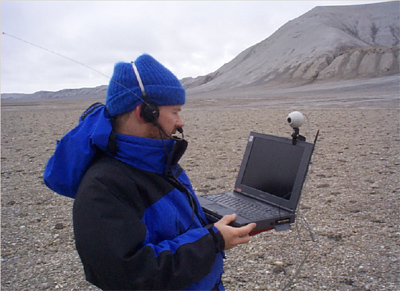






Interview: Dr. Brian Glass
This is the second of a two part interview. Last month, we discussed how Dr. Glass became senior staff scientist at the Computational Sciences Division at NASA-Ames. This month, he shares some insight into some of his current projects.
 |
| Dr. Glass working in the Artic desert. |
The Mars Analog Rio Tinto Experiment [MARTE] uses a simulated Mars lander in Spain that is run remotely by NASA.
Does the work you do with MARTE apply to the current Mars rover mission?
Only tenuously-we're more focused on developing a prototype for possible flight in 2009 or 2011. But the 2005 MARTE field demonstration will incorporate a later version of some of the executive software that we've provided to JPL in support of MER mission operations.
Is there a transcript for the MARTE webcast?
Mine is specifically at: http://robotics.nasa.gov/
courses/fall2003/oct8/index.php It works in RealPlayer or MediaPlayer. The other eight webcasts can be found through the MARTE homepage.
(The Mars Underground Mole [MUM] uses a small metal cylinder that vibrates down into the Martian subsoil)
What inspired that project?
The original moles actually came from 2 meter-long, late-80s Soviet designs, used in Siberian permafrost.
What's it like working with the Germans?
The Germans' mechanical specs and drawings are excellent. Coordination regarding meetings and design reviews has been hard. They're highly capable and competent but significantly underfunded, even compared with NASA.
(The Mars Arctic Drilling Demonstration [MADD] uses an Arctic desert site to simulate Martian drilling experiments)
What's the best part of going to the Arctic, for you?
It's a good analog site, and not just in the sense of having subsurface ice, no plant cover, nearly sterile soil, cold and dry conditions, and impact crater features. It's also because it is a challenge to get there and to make things work under those conditions. There's no Fry's Electronics 5 miles away. There's no safety net, no medical facilities, no machine shops; everything must be self-contained.
That enforces a real-world discipline on participants. They have to design things to be easily assembled, lightweight, field-repairable and rugged. The very harshness and remoteness of the Arctic deserts adds to their primary value as Mars analogs. And there's a certain psychological satisfaction in overcoming those obstacles to carry off a successful field test-more than if I was running the same test in my back yard.
(The Human Robotic Productivity Study [HORSE] compares the performance of spacesuited humans to remotely directed rovers in doing field geology tasks)
Were you involved with the spacesuit development work with NSS?
Only peripherally. NSS gave a grant to the Haughton-Mars Project in 2002 for evaluation of the Hamilton-Sundstrand prototype suit in an analog environment, and I helped with the project. Subsequently, I had a project that used the same suit to evaluate field geology productivity-comparing the performance of a spacesuited human with a shirtsleeved geologist and a remote-operated rover.
How do the results for that study look so far? Is there reason to promote one over the other?
Spacesuited humans are about three to five times more productive than future, autonomous 2015-class rovers. Add an order of magnitude if one compares them to the current MER-class rovers instead. And geologists in shirtsleeves are about an order of magnitude more productive than a spacesuited human. So that's roughly 300 to 400 times greater productivity between current rovers and shirtsleeved geologists, which isn't surprising.
Copyright © 1998-2005 Organization for the Advancement of Space Industrialization and Settlement. All Rights Reserved.